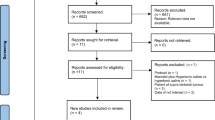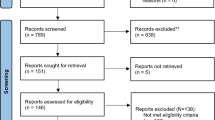Abstract
Hyperosmolar therapy is regarded as the mainstay for treatment of elevated intracranial pressure (ICP) in traumatic brain injury (TBI). This still has been disputed as application of hypertonic saline (HS) or mannitol for treating patients with severe TBI. Thus, this meta-analysis was performed to further compare the advantages and disadvantages of mannitol with HS for treating elevated ICP after TBI. We conducted a systematic search on PubMed, EMBASE, Cochrane Central Register of Controlled Trials (CENTRAL), Wan Fang Data, VIP Data, SinoMed, and China National Knowledge Infrastructure (CNKI) databases. Studies were included or not based on the quality assessment by the Jadad scale and selection criteria. Twelve RCTs with 438 patients were enrolled for the meta-analysis. The comparison of HS and mannitol indicated that they were close in field of improving function outcome (RR = 1.17, 95% CI 0.89 to 1.54, p = 0.258) and reducing intracranial pressure (MD = − 0.16, 95% CI: − 0.59 to 0.27, p = 0.473) and mortality (RR = 0.78, 95% CI 0.53 to 1.16, p = 0.216). The pooled relative risk of successful ICP control was 1.06 (95% CI: 1.00 to 1.13, p = 0.044), demonstrating that HS was more effective than mannitol in ICP management. Both serum sodium (WMD = 5.30, 95% CI: 4.37 to 6.22, p < 0.001) and osmolality (WMD = 3.03, 95% CI: 0.18 to 5.88, p = 0.037) were increased after injection of hypertonic saline. The results do not lend a specific recommendation to select hypertonic saline or mannitol as a first-line for the patients with elevated ICP caused by TBI. However, for the refractory intracranial hypertension, hypertonic saline seems to be preferred.











Similar content being viewed by others
References
Nguyen R, Fiest KM, McChesney J, Kwon CS, Jette N, Frolkis AD, Atta C, Mah S, Dhaliwal H, Reid A, Pringsheim T, Dykeman J, Gallagher C (2016) The international incidence of traumatic brain injury: a systematic review and meta-analysis. Can J Neurol Sci 43:774–785
Reza A, Riahi E, Daneshi A, Golchini E (2018) The incidence of traumatic brain injury in Tehran, Iran. Brain Inj 32:487–492
Turgeon AF, Lauzier F, Simard JF, Scales DC, Burns KEA, Moore L, Zygun DA, Bernard F, Meade MO, Dung TC, Ratnapalan M, Todd S, Harlock J, Fergusson DA, for the Canadian Critical Care Trials Group (2011) Mortality associated with withdrawal of life-sustaining therapy for patients with severe traumatic brain injury: a Canadian multicentre cohort study. CMAJ 183:1581–1588
Diaz-Arrastia R, Kochanek PM, Bergold P, Kenney K, Marx CE, Grimes CJB, Loh LTCY, Adam LTCGE, Oskvig D, Curley KC, Salzer CW (2014) Pharmacotherapy of traumatic brain injury: state of the science and the road forward: report of the Department of Defense Neurotrauma Pharmacology Workgroup. J Neurotrauma 31:135–158
Juul N, Morris GF, Marshall SB, Marshall LF (2000) Intracranial hypertension and cerebral perfusion pressure: influence on neurological deterioration and outcome in severe head injury. The executive Committee of the International Selfotel Trial. J Neurosurg 92:1–6
Infanti JL (2008) Challenging the gold standard: should mannitol remain our first-line defense against intracranial hypertension? J Neurosci Nurs 40:362–368
Diringer MN (2016) The evolution of the clinical use of osmotic therapy in the treatment of cerebral edema. Acta Neurochir Suppl 121:3–6
Wakai A, Roberts IG, Schierhout G (2007) Mannitol in acute traumatic brain injury
Boone MD, Oren-Grinberg A, Robinson TM, Chen CC, Kasper EM (2015) Mannitol or hypertonic saline in the setting of traumatic brain injury: what have we learned? Surg Neurol Int 6:177
Carney N, Totten AM, O'Reilly C, Ullman JS, Hawryluk GW, Bell MJ, Bratton SL, Chesnut R, Harris OA, Kissoon N, Rubiano AM, Shutter L, Tasker RC, Vavilala MS, Wilberger J, Wright DW, Ghajar J (2017) Guidelines for the Management of Severe Traumatic Brain Injury. Fourth Edition Neurosurgery 80:6–15
Jadad AR, Moore RA, Carroll D, Jenkinson C, Reynolds DJM, Gavaghan DJ, McQuay HJ (1996) Assessing the quality of reports of randomized clinical trials: is blinding necessary? Control Clin Trials 17:1–12
Gluud LL, Thorlund K, Gluud C, Woods L, Harris R, Sterne JA (2008) Correction: reported methodologic quality and discrepancies between large and small randomized trials in meta-analyses. Ann Intern Med 149:219
Higgins JP, Thompson SG (2002) Quantifying heterogeneity in a meta-analysis. Stat Med 21:1539–1558
Patsopoulos NA, Evangelou E, Ioannidis JP (2008) Sensitivity of between-study heterogeneity in meta-analysis: proposed metrics and empirical evaluation. Int J Epidemiol 37:1148–1157
Du DY, Sun LT, Zhang WS, Li K, Xu C, Li ZF (2017) The clinical efficacy of hypertonic saline in reducing intracranial pressure in patients with severe traumatic brain injury. Neural Injury And Functional Reconstruction 12:215–217
Battison C, Andrews PJD, Graham C, Petty T (2005) Randomized, controlled trial on the effect of a 20% mannitol solution and a 7.5% saline/6% dextran solution on increased intracranial pressure after brain injury*. Crit Care Med 33:196–202
Mao X, Feng D, Fuhua YE (2007) Comparison of mannitol with hypertonic saline in treatment of traumatic brain edema associated with intracranial hypertension. Jiangsu Med J
Sakellaridis N, Pavlou E, Karatzas S, Chroni D, Vlachos K, Chatzopoulos K, Dimopoulou E, Kelesis C, Karaouli V (2011) Comparison of mannitol and hypertonic saline in the treatment of severe brain injuries. J Neurosurg 114:545–548
Yan YF, Yao HB, Shen X, Yao-Dong JI (2013) Hypertonic saline for the treatment of intracranial hypertension due to traumatic brain edema. J Trauma Surg
Huang X, Yang L (2014) Comparison of 20% mannitol and 15% hypertonic saline in doses of similar osmotic burden for treatment of severe traumatic brain injury with intracranial Hypertension. J South Med Univ 34:723–726
Harutjunyan L, Holz C, Rieger A, Menzel M, Grond S, Soukup J (2005) Efficiency of 7.2% hypertonic saline hydroxyethyl starch 200/0.5 versus mannitol 15% in the treatment of increased intracranial pressure in neurosurgical patients - a randomized clinical. Trials Crit Care 9:R530–R540
Francony G, Fauvage B, Falcon D, Canet C, Dilou H, Lavagne P, Jacquot C, Payen JF (2008) Equimolar doses of mannitol and hypertonic saline in the treatment of increased intracranial pressure. Crit Care Med 36:795–800
Cottenceau V, Masson F, Mahamid E, Petit L, Shik V, Sztark F, Zaaroor M, Soustiel JF (2011) Comparison of effects of equiosmolar doses of mannitol and hypertonic saline on cerebral blood flow and metabolism in traumatic brain injury. J Neurotrauma 28:2003–2012
Qin DG, Huang WY, Yang L et al (2016) Hypertonic saline in treatment of intracranial hypertension CalILsed by severe cerebral trauma after decompressive craniectomy. Chin J Neuromed 15:1267–1273
Jagannatha AT, Sriganesh K, Devi BI, Rao GS (2016) An equiosmolar study on early intracranial physiology and long term outcome in severe traumatic brain injury comparing mannitol and hypertonic saline. J Clin Neurosci 27:68–73
Vialet R, Albanese J, Thomachot L et al (2003) Isovolume hypertonic solutes (sodium chloride or mannitol) in the treatment of refractory posttraumatic intracranial hypertension: 2 mL/kg 7.5% saline is more effective than 2 mL/kg 20% mannitol. Crit Care Med 31:1683–1687
Burgess S, Abu-Laban RB, Slavik RS, Vu EN, Zed PJ (2016) A systematic review of randomized controlled trials comparing hypertonic sodium solutions and mannitol for traumatic brain injury: implications for emergency department management. Ann Pharmacother 50:291–300
Berger-Pelleiter E, Emond M, Lauzier F, Shields JF, Turgeon AF (2016) Hypertonic saline in severe traumatic brain injury: a systematic review and meta-analysis of randomized controlled trials. CJEM 18:112–120
Kamel H, Navi BB, Nakagawa K, Hemphill JC 3rd, Ko NU (2011) Hypertonic saline versus mannitol for the treatment of elevated intracranial pressure: a meta-analysis of randomized clinical trials. Crit Care Med 39:554–559
Rickard AC, Smith JE, Newell P, Bailey A, Kehoe A, Mann C (2014) Salt or sugar for your injured brain? A meta-analysis of randomised controlled trials of mannitol versus hypertonic sodium solutions to manage raised intracranial pressure in traumatic brain injury. Emerg Med J 31:679–683
Li M, Chen T, Chen SD, Cai J, Hu YH (2015) Comparison of equimolar doses of mannitol and hypertonic saline for the treatment of elevated intracranial pressure after traumatic brain injury: a systematic review and meta-analysis. Medicine (Baltimore) 94:e736
Eichner E (1972) Problems associated with the rhythm method of contraception. Am J Obstet Gynecol 113:855
Lazaridis C, Neyens R, Bodle J, DeSantis SM (2013) High-osmolarity saline in neurocritical care: systematic review and meta-analysis. Crit Care Med 41:1353–1360
Ware ML, Nemani VM, Meeker M, Lee C, Morabito DJ, Manley GT (2005) Effects of 23.4% sodium chloride solution in reducing intracranial pressure in patients with traumatic brain injury: a preliminary study. Neurosurgery 57:727–736
Mortazavi MM, Romeo AK, Deep A, Griessenauer CJ, Shoja MM, Tubbs RS, Fisher W (2012) Hypertonic saline for treating raised intracranial pressure: literature review with meta-analysis. J Neurosurg 116:210–221
Eskandari R, Filtz MR, Davis GE, Hoesch RE (2013) Effective treatment of refractory intracranial hypertension after traumatic brain injury with repeated boluses of 14.6% hypertonic saline. J Neurosurg 119:338–346
Pietrini V, Mozzani F, Crafa P, Sivelli R, Cademartiri F, Crisi G (2010) Central pontine and extrapontine myelinolysis despite careful correction of hyponatremia: clinical and neuropathological findings of a case. Neurol Sci 31:227–230
Erdman MJ, Riha H, Bode L, Chang JJ, Jones GM (2017) Predictors of acute kidney injury in Neurocritical care patients receiving continuous hypertonic saline. Neurohospitalist 7:9–14
Funding
This work was supported by the National Natural Science Foundation of China (NSFC, 31300927), the Medical Scientific Research Foundation of Guangdong Province (grant number: A2016496), and Key, the Pearl River S&T Nova Program of Guangzhou (201710010047).
Author information
Authors and Affiliations
Corresponding author
Ethics declarations
Conflicts of interest
The authors declare that they have no competing interests.
Ethical approval and informed consent
Ethical approval was not required. All the studies contained in this article were in compliance with ethical standards and have been published online. All the presented data were anonymized and there is no risk of identification.
Rights and permissions
About this article
Cite this article
Gu, J., Huang, H., Huang, Y. et al. Hypertonic saline or mannitol for treating elevated intracranial pressure in traumatic brain injury: a meta-analysis of randomized controlled trials. Neurosurg Rev 42, 499–509 (2019). https://doi.org/10.1007/s10143-018-0991-8
Received:
Revised:
Accepted:
Published:
Issue Date:
DOI: https://doi.org/10.1007/s10143-018-0991-8




